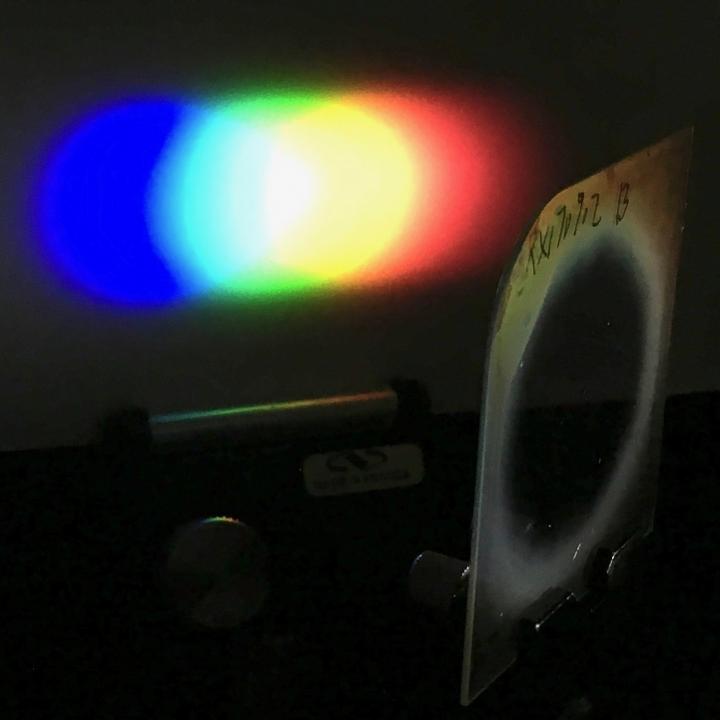
This photo shows a one-inch diameter Bragg polarization grating diffracts white light from an LED flashlight onto a screen placed nearby. Even though the difference between the light’s input and output direction is very large, the grating is highly efficient for a wide set of input angles. The extremely large color separation occurs because the grating structure has a nanoscale periodic structure smaller than the wavelength of visible light. A paper on the work was published May 8, 2018, in Scientific Reports. Credit: Michael Escuti, NC State University
Engineering and physics researchers at North Carolina State University have developed a new technology for steering light that allows for more light input and greater efficiency – a development that holds promise for creating more immersive augmented-reality display systems.
At issue are diffraction gratings, which are used to manipulate light in everything from electronic displays to fiber-optic communication technologies.
“Until now, state-of-the-art diffraction gratings configured to steer visible light to large angles have had an angular acceptance range, or bandwidth, of about 20 degrees, meaning that the light source has to be directed into the grating within an arc of 20 degrees,” says Michael Escuti, a professor of electrical and computer engineering at NC State and corresponding author of a paper on the work. “We’ve developed a new grating that expands that window to 40 degrees, allowing light to enter the grating from a wider range of input angles.
“The practical effect of this – in augmented-reality displays, for example – would be that users would have a greater field of view; the experience would be more immersive,” says Escuti, who is also the chief science officer of ImagineOptix Corp., which funded the work and has licensed the technology.
The new grating is also significantly more efficient.
“In previous gratings in a comparable configuration, an average of 30 percent of the light input is being diffracted in the desired direction,” says Xiao Xiang, a Ph.D. student at NC State and lead author of the paper. “Our new grating diffracts about 75 percent of the light in the desired direction.”
This advance could also make fiber-optic networks more energy efficient, the researchers say.
The new grating achieves the advance in angular bandwidth by integrating two layers, which are superimposed in a way that allows their optical responses to work together. One layer contains molecules that are arranged at a “slant” that allows it to capture 20 degrees of angular bandwidth. The second layer is arranged at a different slant, which captures an adjacent 20 degrees of angular bandwidth.
The higher efficiency stems from a smoothly varying pattern in the orientation of the liquid crystal molecules in the grating. The pattern affects the phase of the light, which is the mechanism responsible for redirecting the light.
“The next step for this work is to take the advantages of these gratings and make a new generation of augmented-reality hardware,” Escuti says.
The paper, “Bragg polarization gratings for wide angular bandwidth and high efficiency at steep deflection angles,” is published in the journal Scientific Reports. The paper was co-authored by Jihwan Kim, a research assistant professor of electrical and computer engineering at NC State.




